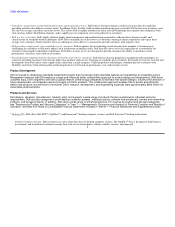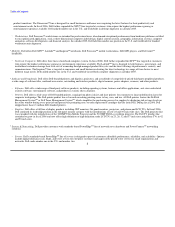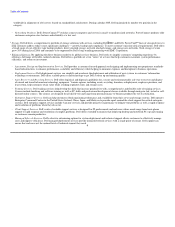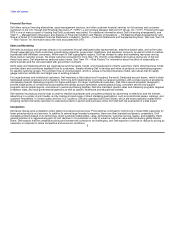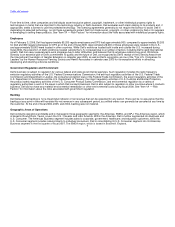Dell 2005 Annual Report Download - page 10
Download and view the complete annual report
Please find page 10 of the 2005 Dell annual report below. You can navigate through the pages in the report by either clicking on the pages listed below, or by using the keyword search tool below to find specific information within the annual report.
Table of Contents
From time to time, other companies and individuals assert exclusive patent, copyright, trademark, or other intellectual property rights to
technologies or marks that are important to the technology industry or Dell's business. Dell evaluates each claim relating to its products and, if
appropriate, seeks a license to use the protected technology. The licensing agreements generally do not require the licensor to assist Dell in
duplicating its patented technology, nor do these agreements protect Dell from trade secret, copyright, or other violations by Dell or its suppliers
in developing or selling these products. See "Item 1A — Risk Factors" for information about the risks associated with intellectual property rights.
Employees
As of February 3, 2006, Dell had approximately 65,200 regular employees and DFS had approximately 900, compared to approximately 55,200
for Dell and 800 regular employees for DFS as of the end of fiscal 2005. Approximately 26,200 of these employees were located in the U.S.,
and approximately 39,900 were located in other countries. While Dell's workforce located both inside and outside the U.S. increased during
fiscal 2006, the proportion of Dell's workforce located outside the U.S. increased due to a number of factors, including Dell's rapid international
growth. Dell has never experienced a work stoppage due to labor difficulties, and believes that its employee relations are good. Workforce
diversity is an essential part of Dell's commitment to quality and the future of Dell, as recognized by Dell's receipt of the Diversity Award from
the International Foundation of Gender Education in calendar year 2005, as well as Dell's recognition as one of the "Top U.S. Companies for
Leaders" by the Human Resource Planning Society and Hewitt Associates in calendar year 2005 for its exceptional efforts in attracting,
developing and retaining a diverse workforce.
Government Regulation and Environment
Dell's business is subject to regulation by various federal and state governmental agencies. Such regulation includes the radio frequency
emission regulatory activities of the U.S. Federal Communications Commission, the anti-trust regulatory activities of the U.S. Federal Trade
Commission and Department of Justice, the consumer protection laws of the Federal Trade Commission, the export regulatory activities of the
U.S. Department of Commerce and the U.S. Department of Treasury, the import regulatory activities of U.S. Customs and Border Protection,
the product safety regulatory activities of the U.S. Consumer Product Safety Commission, and environmental regulation by a variety of
regulatory authorities in each of the areas in which Dell conducts business. Dell is also subject to regulation in other countries where it conducts
business. Dell did not have any material environmental remediation or other environmental costs during fiscal 2006. See "Item 1A — Risk
Factors" for information about the risks associated with government regulation.
Backlog
Dell believes that backlog is not a meaningful indicator of net revenue that can be expected for any period. There can be no assurance that the
backlog at any point in time will translate into net revenue in any subsequent period, as unfilled orders can generally be canceled at any time by
the customer. At the end of fiscal 2006, 2005, and 2004, backlog was not material.
Geographic Areas of Operations
Dell conducts operations worldwide and is managed in three geographic segments: the Americas, EMEA, and APJ. The Americas region, which
is based in Round Rock, Texas, covers the U.S., Canada, and Latin America. Within the Americas, Dell is further segmented into Business and
U.S. Consumer. The Americas Business segment includes sales to corporate, government, healthcare, and education customers, while the
U.S. Consumer segment includes sales primarily to individual consumers. Dell is consolidating its U.S. Consumer segment into its Americas
Business segment in the first quarter of fiscal 2007. The EMEA region, which is based in Bracknell, England,
7





